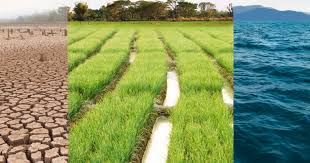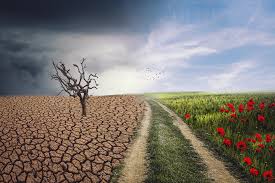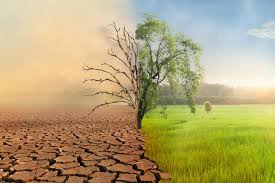Climate change refers to long-term alterations in temperature, precipitation, wind patterns, and other elements of the Earth’s climate system. It poses significant challenges to agriculture, affecting food production, water availability, and the overall health of ecosystems.
Understanding the impact of climate change on agriculture is crucial for ensuring food security and developing effective strategies for adaptation and mitigation.
Effects of Climate Change on Crop Yields
Climate change influences crop yields in various ways, primarily through changes in temperature and precipitation patterns.
1. Temperature Increases: Rising temperatures can lead to reduced crop yields. Most crops have optimal temperature ranges for growth. When temperatures exceed these ranges, crop development may slow, and yields may decline. For example, a temperature increase of just 1°C can reduce wheat yields by 6%.
2. Changes in Rainfall Patterns: Climate change affects rainfall distribution, leading to both droughts and flooding. Drought conditions can stress plants, reduce growth, and lead to lower yields. On the other hand, excessive rainfall can cause waterlogging, soil erosion, and crop damage.
3. Increased Pests and Diseases: Warmer temperatures and changing weather patterns can lead to an increase in pest populations and the spread of plant diseases, further threatening crop yields. For example, the spread of aphids and other pests can reduce crop productivity.
4. Altered Growing Seasons: Climate change may shift growing seasons, causing discrepancies between planting and harvesting times. Crops may not mature as expected, leading to lower yields.
5. CO2 Fertilization Effect: Higher levels of carbon dioxide (CO2) can enhance photosynthesis, potentially increasing yields for some crops. However, this effect is often counterbalanced by other stressors associated with climate change, such as heat and water scarcity.
Water Availability in the Context of Climate Change

Water is a critical resource for agriculture, and climate change significantly impacts its availability.
1. Altered Precipitation Patterns: Changes in rainfall patterns can lead to water scarcity in some regions and flooding in others. Regions that rely on consistent rainfall for irrigation may experience reduced water availability, impacting crop production.
2. Melting Glaciers: In some areas, glaciers provide essential water resources for irrigation. Climate change causes glaciers to melt, which initially increases water flow but eventually leads to water shortages as the glaciers diminish over time.
3. Groundwater Depletion: Increased evaporation rates due to higher temperatures can lead to greater water loss from soils and water bodies, reducing available groundwater supplies. This depletion affects farmers reliant on wells for irrigation.
4. Competition for Water Resources: As water becomes scarcer, competition between agricultural and urban needs may intensify. Farmers may face higher costs for water or restrictions on usage, affecting agricultural productivity.
The Relationship Between Climate Change and Extreme Weather Events
Climate change contributes to an increase in the frequency and severity of extreme weather events, which can have devastating effects on agriculture.
1. Droughts: Prolonged periods of low rainfall can lead to droughts, severely impacting crop yields and livestock. Drought can result in soil degradation and increased reliance on irrigation, stressing water resources.
2. Flooding: Intense rainfall and storm events can cause flooding, leading to soil erosion, crop loss, and damage to infrastructure. Flooded fields can be rendered unusable for extended periods.
3. Hurricanes and Storms: The intensity of hurricanes and storms may increase due to climate change, resulting in significant damage to crops, farms, and storage facilities. The aftermath can disrupt food supply chains.
4. Heatwaves: Increased frequency of heatwaves can stress crops, leading to reduced yields and increased evaporation. Livestock may also suffer from heat stress, affecting their health and productivity.
5. Changing Pest and Disease Patterns: Extreme weather can alter the habitats of pests and pathogens, potentially leading to increased outbreaks in agricultural areas. Farmers must adapt to these changing threats to protect their crops.
Read Also: How often you need to Change Water in your Fish Farm
Regional Variations in Climate Change Impact

The impact of climate change varies significantly by region, influenced by local climate conditions, agricultural practices, and socio-economic factors. Understanding these regional variations helps tailor adaptation strategies.
1. Tropical Regions: In tropical areas, increased temperatures and altered rainfall patterns can lead to reduced crop yields for staple foods like rice and maize. Droughts may become more common, stressing water resources and impacting food security.
2. Temperate Regions: Temperate regions may experience a longer growing season due to warmer temperatures, but increased rainfall can lead to flooding and soil erosion. This may affect crops like wheat and barley, necessitating adjustments in planting times and practices.
3. Arid and Semi-Arid Regions: These areas are particularly vulnerable to droughts, which can severely impact water availability for irrigation. Adaptation may include implementing water-saving irrigation techniques and selecting drought-resistant crop varieties.
4. Polar Regions: Although agriculture is limited in polar areas, changes in climate can impact indigenous farming practices and food systems, particularly as permafrost thaws and alters the landscape.
5. Coastal Regions: Rising sea levels and increased salinity can threaten agricultural land in coastal areas. Farmers may need to adopt practices that improve soil health and reduce salt intrusion.
Adaptation Strategies for Farmers
Farmers can implement various adaptation strategies to cope with the impacts of climate change on agriculture.
1. Crop Diversification: Growing a variety of crops can reduce the risk of total crop failure due to climate stressors. This strategy can help ensure food security and improve resilience against pests and diseases.
2. Improved Water Management: Efficient irrigation practices, such as drip irrigation and rainwater harvesting, can help conserve water and ensure crops receive adequate moisture. Farmers can also invest in soil moisture monitoring systems.
3. Soil Health Management: Practices like cover cropping, crop rotation, and reduced tillage can improve soil health and increase its capacity to retain moisture. Healthy soils are more resilient to climate variations.
4. Use of Climate-Resilient Varieties: Farmers can select and breed crop varieties that are more tolerant to drought, heat, and pests. This can enhance yields and reduce vulnerability to climate change.
5. Agroforestry: Integrating trees and shrubs into agricultural landscapes can improve soil health, enhance biodiversity, and provide additional sources of income. Trees can also provide shade for crops and livestock, reducing heat stress.
6. Education and Training: Providing farmers with access to information about climate change and sustainable practices can empower them to make informed decisions. Training programs can focus on adaptive techniques and innovations.
Read Also: 14 Medicinal Health Benefits of Ghost Pepper (Capsicum Chinese)
Mitigation Efforts to Combat Climate Change

Mitigation efforts aim to reduce greenhouse gas emissions from agriculture and enhance carbon sequestration.
1. Sustainable Land Management: Practices such as agroecology, organic farming, and conservation agriculture can improve soil health and reduce emissions. These methods emphasize biodiversity and ecosystem services.
2. Improved Fertilizer Use: Efficient fertilizer application can reduce nitrous oxide emissions. Practices like precision farming and using organic fertilizers can minimize environmental impact.
3. Livestock Management: Implementing better grazing practices and manure management can reduce methane emissions from livestock. Integrated livestock-crop systems can also enhance overall productivity.
4. Carbon Sequestration: Farmers can adopt practices that increase carbon storage in soils, such as agroforestry and cover cropping. This not only reduces atmospheric CO2 but also improves soil fertility.
5. Waste Reduction: Reducing food waste at all stages of the supply chain can help decrease greenhouse gas emissions. This includes improving storage, transportation, and processing methods.
6. Renewable Energy Use: Farmers can utilize renewable energy sources, such as solar and wind, to power their operations. This transition reduces reliance on fossil fuels and lowers carbon emissions.
Climate change poses significant challenges for agriculture, affecting crop yields, water availability, and increasing the frequency of extreme weather events. Addressing these challenges requires proactive measures, including developing climate-resilient crop varieties, implementing efficient water management practices, and adopting sustainable farming techniques.
By understanding the relationship between climate change and agriculture, stakeholders can work together to ensure food security and protect agricultural systems for future generations.
Do you have any questions, suggestions, or contributions? If so, please feel free to use the comment box below to share your thoughts. We also encourage you to kindly share this information with others who might benefit from it. Since we can’t reach everyone at once, we truly appreciate your help in spreading the word. Thank you so much for your support and for sharing!






